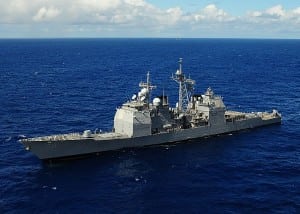The Navy’s fiscal year 2025 budget request seeks to retire 10 ships earlier than planned after a hull-by-hull analysis, officials said.
The Navy is looking to decommission the Ticonderoga
-class USS Shiloh (CG-67) and Lake Erie (CG-70), both within two to three years of planned service lives; the Independence-variant Littoral Combat Ships USS Jackson (LCS-6) and USS Montgomery (LCS-8); the USS Germantown (LSD-42) Whidbey Island-class dock landing ship, which is a year out from its expected service life; the four oldest Spearhead-class expeditionary fast transport ships USNS Spearhead (EPF-1), Choctaw County (EPF-2), Millinocket (EPF-3) and Fall River (EPF-4); and the USNS John Glenn (ESD-2) Montford Point-class Expeditionary Transfer Dock ship.
Under Secretary of the Navy Erik Raven told reporters last Friday ahead of the budget release that “what’s really important as we make these difficult choices, is making sure we do a hull by hull analysis of how each ship fits into a fleet with its capabilities and its material status as being prime concerns.”

Last year, the Navy requested retiring CG-67 and LSD-42 early. The Navy has sought to retire LSD-42 early in the previous two budget requests.
In 2023, Secretary of the Navy Carlos Del Toro argued the early decommissioning of these kinds of older amphibious ships gives the “most bang for the buck” while they may only able to deploy for short periods given high maintenance requirements. He also wanted to redirect money from the cruisers to more new Arleigh Burke-class destroyers and Constellation-class frigates (Defense Daily, March 22, 2023).
Raven reiterated the LCS decision is consistent with recent years’ requests and analyses to divest of LCS “excess to the validated requirements” of 15 mine countermeasures ships and 10 surface warfare-capable ships.
Raven also said the Navy can divest the aging LSD-42 because the Navy has put the San Antonio-class Flight II amphibious transport dock ships back on the schedule at one ship every two years in the five year-long Future Years Development Program (FYDP), starting with one in FY ‘25.
Congress previously criticized the Navy for pausing LPD procurement plans in a review, which would keep amphibious vessels under the congressionally-mandated floor of 31 ships.
“This budget presents a plan for the continued LPD production and retirement of that hull will allow us, with the delivery of the next LPD, to keep us at that 31 requirement,” he said.
Rear Adm. Ben Reynolds, deputy assistant secretary of the Navy for budget, said the service invested “heavily across the FYDP to get to a stable place.”
He said when looking at each ship on the list, “it would take a substantial amount of funding to get to the requirements to get to the modernization, the lethality, that they need to be part of the fight.”
Reynolds argued the Navy is “beyond what I would call the knee in the curve for a return on investment” on modernizing and increasing lethality on littoral combat ships 6 and 8.
He added that the Navy is balancing what each ship on the list brings and where it can spend the money elsewhere to field capacity and capability elsewhere in the fleet.